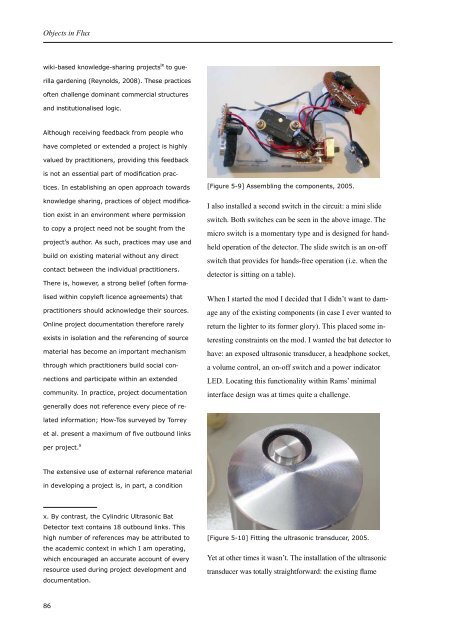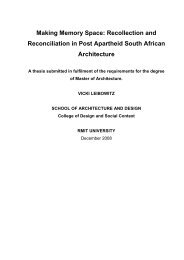Objects in Flux - RMIT Research Repository - RMIT University
Objects in Flux - RMIT Research Repository - RMIT University
Objects in Flux - RMIT Research Repository - RMIT University
Create successful ePaper yourself
Turn your PDF publications into a flip-book with our unique Google optimized e-Paper software.
<strong>Objects</strong> <strong>in</strong> <strong>Flux</strong><br />
wiki-based knowledge-shar<strong>in</strong>g projects ix to gue-<br />
rilla garden<strong>in</strong>g (Reynolds, 2008). These practices<br />
often challenge dom<strong>in</strong>ant commercial structures<br />
and <strong>in</strong>stitutionalised logic.<br />
Although receiv<strong>in</strong>g feedback from people who<br />
have completed or extended a project is highly<br />
valued by practitioners, provid<strong>in</strong>g this feedback<br />
is not an essential part of modification prac-<br />
tices. In establish<strong>in</strong>g an open approach towards<br />
knowledge shar<strong>in</strong>g, practices of object modifica-<br />
tion exist <strong>in</strong> an environment where permission<br />
to copy a project need not be sought from the<br />
project’s author. As such, practices may use and<br />
build on exist<strong>in</strong>g material without any direct<br />
contact between the <strong>in</strong>dividual practitioners.<br />
There is, however, a strong belief (often forma-<br />
lised with<strong>in</strong> copyleft licence agreements) that<br />
practitioners should acknowledge their sources.<br />
Onl<strong>in</strong>e project documentation therefore rarely<br />
exists <strong>in</strong> isolation and the referenc<strong>in</strong>g of source<br />
material has become an important mechanism<br />
through which practitioners build social con-<br />
nections and participate with<strong>in</strong> an extended<br />
community. In practice, project documentation<br />
generally does not reference every piece of re-<br />
lated <strong>in</strong>formation; How-Tos surveyed by Torrey<br />
et al. present a maximum of five outbound l<strong>in</strong>ks<br />
per project. x<br />
The extensive use of external reference material<br />
<strong>in</strong> develop<strong>in</strong>g a project is, <strong>in</strong> part, a condition<br />
x. By contrast, the Cyl<strong>in</strong>dric Ultrasonic Bat<br />
Detector text conta<strong>in</strong>s 18 outbound l<strong>in</strong>ks. This<br />
high number of references may be attributed to<br />
the academic context <strong>in</strong> which I am operat<strong>in</strong>g,<br />
which encouraged an accurate account of every<br />
resource used dur<strong>in</strong>g project development and<br />
documentation.<br />
86<br />
[Figure 5-9]<br />
Assembl<strong>in</strong>g the components, 2005.<br />
I also <strong>in</strong>stalled a second switch <strong>in</strong> the circuit: a m<strong>in</strong>i slide<br />
switch. Both switches can be seen <strong>in</strong> the above image. The<br />
micro switch is a momentary type and is designed for handheld<br />
operation of the detector. The slide switch is an on-off<br />
switch that provides for hands-free operation (i.e. when the<br />
detector is sitt<strong>in</strong>g on a table).<br />
When I started the mod I decided that I didn’t want to damage<br />
any of the exist<strong>in</strong>g components (<strong>in</strong> case I ever wanted to<br />
return the lighter to its former glory). This placed some <strong>in</strong>terest<strong>in</strong>g<br />
constra<strong>in</strong>ts on the mod. I wanted the bat detector to<br />
have: an exposed ultrasonic transducer, a headphone socket,<br />
a volume control, an on-off switch and a power <strong>in</strong>dicator<br />
LED. Locat<strong>in</strong>g this functionality with<strong>in</strong> Rams’ m<strong>in</strong>imal<br />
<strong>in</strong>terface design was at times quite a challenge.<br />
[Figure 5-10]<br />
Fitt<strong>in</strong>g the ultrasonic transducer, 2005.<br />
Yet at other times it wasn’t. The <strong>in</strong>stallation of the ultrasonic<br />
transducer was totally straightforward: the exist<strong>in</strong>g flame
















